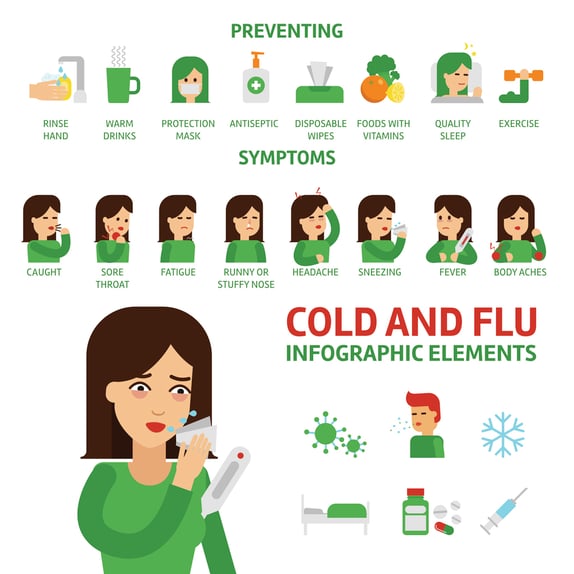
There may be genetic shape-shifting mutants in your building, and it’s not because it’s Halloween season. They’re influenza viruses, and they continuously transform in response to their environment and to evade the human immune system.
Every year there are up to 650,000 deaths globally, 3-5 million severe cases and up to 1 billion people affected by the flu according to the World Health Organization. Highly contagious, these viruses are among the top 10 leading causes of death in the United States, according to Medical News Today. Last year, the flu hospitalized more than 900,000 Americans and killed 80,000, according to the Centers for Disease Control (CDC).
As a continuation of last week’s blog about preparing your facility for flu season, this week we will discuss ways technology can help your facility combat those nasty viruses by reducing their ability to spread or grow.
The flu virus can survive for 24 hours on most surfaces. Use technology to reduce multi-touch areas and deal with the rest.
Reduce the number of high-touch areas in your facility by removing the “touch” portion of things that people do every day. In bathrooms, no-touch flushing, soap dispensers, faucets, air dryers or paper towels can help remove the number of germs that spread from one person to another. In kitchen, break and meeting areas, adding automated, no-touch technology helps reduce the number of germs being spread even more. Automated doors and no-touch antiseptic dispensers placed at entryways can help cut down on germ-ridden hands continuing to pass the contagion throughout the facility.
Since some germs can live for a long time on surfaces, you can install UV Technology to kill germs on multiple surfaces. UV rooms can create a completely sanitized area in a matter of seconds, but the technology is expensive and the room must be empty prior to UV cleaning. UV sanitizing wands and room sanitizers can kill up to 99.9 percent of germs, viruses, bacteria, allergens, dust mite and flea eggs from hard surfaces and fabrics. Smaller versions are portable, easy to use and can be a good addition to any facility.
Pathogens like the flu virus can be spread from person to person up to seven days before symptoms are visible.
The influenza virus can live up to 7 days and incubate before showing many symptoms. In that incubation period, people can still be contagious and spread their germs. A contagious person with the flu virus can spread it to someone else up to 6 feet away and the germs can live up to 24 hours on many surfaces.
Work from home technology allows employees who may be feeling slightly under the weather, or have ill housemates, to keep their germs at home. Most parents know that once a virus gets into their home, it usually must go through each person in the household, at least once, before a bill of health can be issued. However, most employees don’t have the extra time to stay home throughout the incubation and contagious period. Therefore, until someone is sick, and usually comes into the facility and brings the germs with them.
Every job cannot be completed from home, but in areas where it is possible, establishing the ability and a process for certain situations will allow employees to keep viruses at home and not spread germs to other employees.
Since the flu virus is most commonly spread through the air, having strong air quality is important during flu season.
Improve ventilation and air quality by reducing the concentration of indoor contaminants. Use ventilation fans that send air outdoors to increase airflow to have a positive impact on indoor air quality. You can open a window and direct air out of any sealed space or install new exhaust systems. It depends on your situation. It may not always be feasible to open windows or doors or operate a ventilation fan.
Adding portable air cleaners and filters can assist in removing pollutants from inside your facility as well. HEPA filters can remove 99.9% of air particles from the air that is pushed through them. Place HEPA filters in all areas they make sense. Make sure your facility uses vacuums equipped with HEPA filters and update HEPA filters in air purifiers and HVAC systems more often. They can also be used with fans and other air circulation instruments to help remove air particles before circulating them further.
Education is one of the best ways to teach others about the virus and keep it from spreading.
Use your internal learning system or intranet to teach staff about the influenza virus, how contagious it is, and ways to combat the virus both at home and in the office. Educate them on subjects like:
- Why it’s important to get immunization shots, where they are available and how to save money or time.
- What to do if they’re feeling under the weather, and what steps and precautions they should take.
- Tips for cleaning their home and handwashing tips for their family.
- Share information about their corporate healthcare plan, if Health Savings or Flexible Savings are available and who to contact with questions.
Use information from corporate wellness programs, health providers, HR, etc. and place it in a way that makes sense to employees who want to stay healthy this flu season.
This will not only show your workforce that you care but provide them the tools to combat an ever-changing virus before it takes over their system. It will help them keep their homes livelier, your facility healthier and their family stronger.
For helpful materials to communicate with your occupants about viruses and ways to combat them, review Flu Resources for Business from the CDC.





Leave a Comment